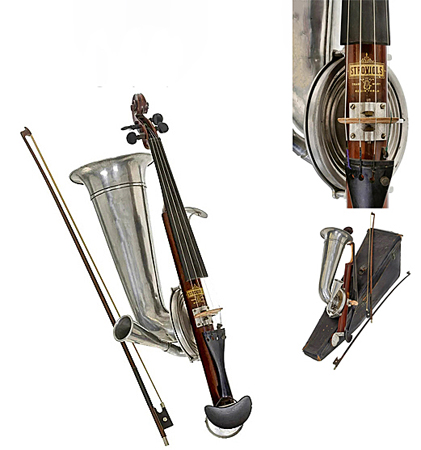
Owner: HWMC
Catalog#: 2CL-CHLT-131
Violin Family
'Strohviol' - John Matthias Augustus Stroh
London, England
John Matthias Augustus Stroh (George Evans & Company, 1904-1942)
Mahogany, aluminum, ebony
ca. 1910’s
Length: 23.5 inches
Strings – Lutes – Violin Family
Gold painted label: STROVIOLS / TRADE (Lyre symbol) MARK / REGISTERED
Engraved above chin rest: MADE IN ENGLAND
This twin-horned Stroh violin (‘Stroviol’ – Resophonic Violin) with four strings and an ebony fingerboard does not have a wooden sound box but instead a metal cone diaphragm and 2 detachable aluminum horns. It was used for recordings of phonograph cylinders. Included is the original case and two bows.
The Stroh violin (‘Strohviol’) was patented (English Patent #9418) by John Matthias Augustus Stroh in London England on May 4, 1899. Stroh was born in Frankfurt am Main in 1828, and was an apprentice watch and clock maker, who immigrated to England in 1851. He invented many acoustical devices, including the first gramophone to be demonstrated in Britain. Thus, the concept of this violin patent originated from work on the mechanical sound box of the gramophone. Later, in 1901 (UK patent 3393), he patented an aluminum conical diaphragm for it as well as for phonographs and other analogous sound producing, recording, or transmitting devices.
Another important feature he added soon after its invention was a small horn attached to the larger horn or to the diaphragm, so that the violinist might hear themselves better when playing with louder instruments such as brass instruments. Stroh instruments included horned violas, cellos, mandolins, guitars, and ukuleles as well as the violin and were manufactured in London first by his son Charles in 1901, then by George Evans & Co. from 1904-1942.
